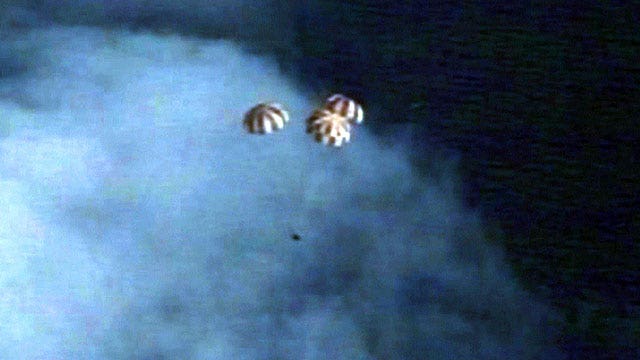Orion flight is major step forward in Mars exploration
Former NASA liaison Ken Christensen weighs in
NASA’s Orion spacecraft has returned safely to Earth after its historic test flight, splashing down in the Pacific Ocean 275 miles west of Baja California at 11:29 a.m. ET.
The splashdown, which was streamed live from a NASA drone, sparked scenes of celebration at the space agency’s Mission Control in Houston.
The unmanned spacecraft successfully blasted off from Cape Canaveral, Fla., at 7:05 a.m. ET., Friday, carried into space by a Delta IV Heavy Rocket. NASA had initially planned to launch Orion on Thursday, but was forced to scrub the liftoff following a series of delays and technical glitches.
NASA lauded the mission as a "textbook" maiden flight.
"Today was a great day for America - we challenge our best and brightest to continue to lead in space," said Orion's Lead Flight Director Mike Sarafin. "While this was an unmanned mission, we were all on board Orion."
The successor to the now-retired Space Shuttles re-entered Earth’s atmosphere at 11:19 a.m. ET, reaching a speed of around 20,000 mph and generating temperatures around 4,000 degrees on the spacecraft’s heat shield.
A series of parachutes successfully slowed the Orion crew module, with its three main parachutes deploying at 11:26 a.m. ET. The module was travelling at about 20 mph when it splashed down.
Orion remained “powered up” for an hour after splashdown, enabling contractor Lockheed Martin to get as much data as possible about the spacecraft’s performance.
After recovery teams from NASA and the U.S. Navy retrieve the module, it will be transported to San Diego aboard the USS Anchorage.
Friday’s 4 hour and 24 minute orbital mission took Orion deeper into space than any spacecraft built for humans has traveled in more than 40 years. Orion, which orbited the Earth twice, hit a maximum altitude of 3,604 miles shortly after 10 a.m. ET.
The crew module successfully separated from its service module at 10:28 a.m ET. Orion passed through the Van Allen radiation belt twice during its journey, with its systems performing perfectly, according to NASA.
Friday's flight, dubbed Exploration Flight Test-1, will provide NASA with vital information on the spacecraft’s performance. NASA plans to eventually use Orion on ambitious manned missions to Mars and an asteroid.
Chris Carberry, executive director of Explore Mars, a non-profit organization that aims to advance the goal of sending humans to Mars within the next two decades, told FoxNews.com that Friday's test flight is an important step forward.
"While Mars could be as many as 20 years off and we don't know exactly what hardware and vehicles will be used, the Orion test starts us on the path toward sending humans beyond Low Earth Orbit," he said. "NASA plans to start going to intermediate destinations in the early 2020s, including the Asteroid Redirect mission - if we are going to accomplish that mission or go to any other destinations in the next few years, it is essential that we start testing hardware - as with EFT-1."
Carberry, however, warned that "sufficient and consistent" budgets should be made available to support the goal of landing humans on Mars by the 2030s.
Orion was rigged with 1,200 sensors to gauge its durability for the day when astronauts climb aboard during the decade ahead.
The $370 million test flight was managed by Lockheed Martin. The Delta IV Heavy Rocket was built by United Launch Alliance.
Future Orion launches will use the mega rocket still under development by NASA, known as SLS or Space Launch System. The first Orion-SLS launch is targeted for 2018, unmanned, followed by the first piloted mission in 2021.
Friday's test flight came at a crucial time for U.S. spaceflight, which has recently suffered some high-profile setbacks. On Oct. 28 an unmanned Antares rocket exploded in a fireball shortly after liftoff from a NASA launchpad in Wallops Island, Virginia. Just three days later Virgin Galactic's SpaceShipTwo space tourism rocket crashed during a test flight over the Mojave Desert, killing one of the two pilots aboard and seriously injuring the other.
The Associated Press contributed to this report.
Follow James Rogers on Twitter @jamesjrogers

